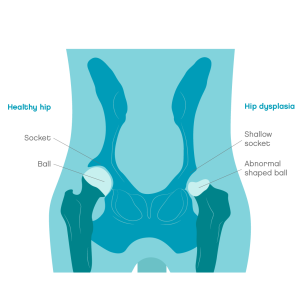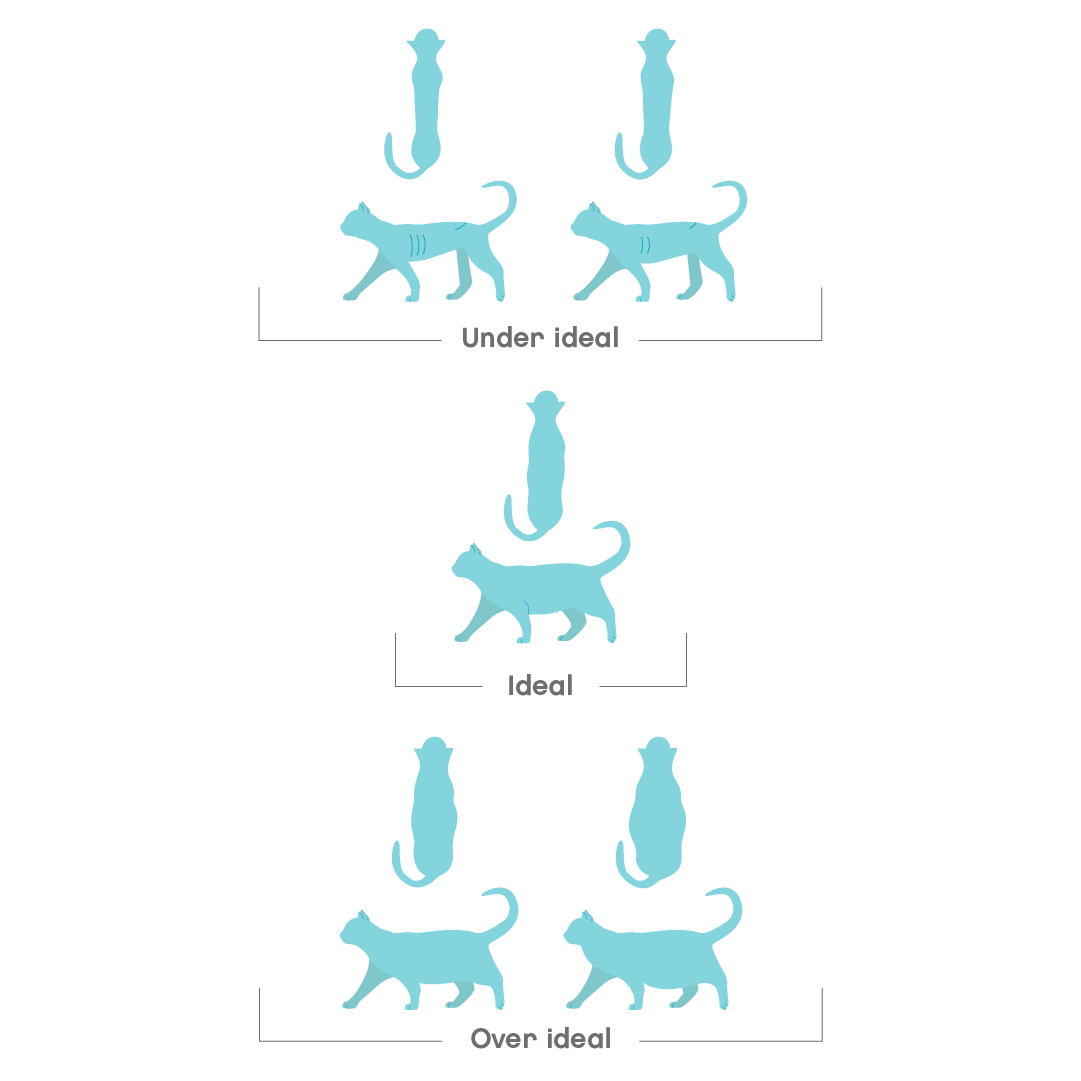Hip dysplasia is an inherited disease. Cats with hip dysplasia can develop secondary osteoarthritis of the affected joint. Maine Coon, Persian, and Himalayan breeds are more likely to develop hip dysplasia, although it can affect any cat.
Hip dysplasia is caused by abnormal development of the hip while the cat is growing. Signs of hip dysplasia in cats are often gradual, making them difficult
to spot. The start of signs can vary between 3 months and 3.5 years of age.
Overview
What is hip dysplasia in cats?
The hips are “ball and socket” joints, which normally fit together perfectly to allow easy movement.
Hip dysplasia in cats is an inherited problem that is not well understood by the scientific community.
The socket (acetabulum) of the hip commonly appears shallowed, resulting in the loosening of the hip joint, which causes dysfunction and pain.
As the cat grows, the cartilage and bone of the hip begin to wear down. Over time, this disease leads to arthritis of the affected joint, muscle loss, and limited mobility.

In the short term, most cats with hip dysplasia will make an improvement when they are managed appropriately.
Long-term improvements are not always as successful.
The majority of cats in later life will have ongoing exercise restrictions and require medications.
Symptoms
How to identify the signs of hip dysplasia in cats
You might notice some or all of the following in your cat:
- Less active
- Limping that is worse after exercise
- Difficulty climbing
- Reluctance to jump
- Inability or reluctance to climb stairs
- Walking in a crouched position
- Howling while resting
- Reluctance to squat to poop
The onset of signs of disease is variable, starting between 3 months and 3.5 years of age.
Risk
Are some cats more at risk of hip dysplasia than others?
Genetics is the main risk factor for this condition.
Maine Coon, Persian, and Himalayan breeds tend to be more likely to develop hip dysplasia, although it can affect any cat.
Diagnosis
How to diagnose hip dysplasia in cats
To help determine whether your cat has hip dysplasia, a vet will:
- Talk through the history of your cat’s life
- Do an orthopaedic examination
- Take radiographs (x-rays)
- Evaluate how loose the hip joint is by manipulating it under sedation or general anaesthesia
Vet treatment
How to treat hip dysplasia in cats
Treatment for hip dysplasia depends on many factors, but the most important is the severity of the condition.
Your vet might recommend one or more of the following treatment options:
- Weight management
- Prescription medications
- Supplements
- Alternative therapies
- Intra articular interventions
- Controlled exercise in acute episodes
- Surgery
Weight management
It is important that your cat is kept at an ideal body condition score of 4-5/9 to prevent excessive weight on their joints. Vet nurses can help you with this.
Body Condition Scoring (BCS) in cats
Body Condition Score (BCS) is a scale that gives a practical evaluation of the fat coverage of your cat’s body. By checking how easy or not it is to feel certain bony areas of the body, a score is then produced. There are several scales, from 1 to 5 or 1 to 9. The ideal body condition lies in the middle, so either 3/5 or 5/9.
The body areas normally checked for fat coverage are:
1. ribs and spine
2. hips and shoulders
3. waist

Here are a few tips on how to do it.
With your pet in a standing position:
- Place your hands on the rib cage and gently feel for each rib, without pressing too hard
- Feel the waist and look from the top and the side (if you have a very furry breed, it may be harder to assess)
- Feel the spine, which runs down the middle of the back
- Feel the top of the hips and shoulders
Medications
The choice of medication is made on an individual basis, and various drugs may be tried before finding the most effective one.
- Anti-inflammatories (NSAIDs)
- Gabapentin
- Amantadine
- Codeine
- Tramadol
- Amitriptyline
Joint supplements
Veterinary-approved nutritional supplements have been shown to:
- Decrease inflammation within the joints
- Slow the progression of arthritis
- Improve general mobility
- Decreasing the amount of anti-inflammatory medication required
The key ingredient a joint supplement should contain is: marine-based sources of omega 3 (such as green-lipped mussels), other ingredients like glucosamine, chondroitin sulfate, and hyaluronic acid may also be beneficial.
Alternatively, there are foods available that already contain joint supplements.
Note that many supplements available online and in pet shops do not have proven health benefits. If you need guidance speak to a vet.
Alternative therapies
Complementary therapies are often used alongside conventional treatment to help control hip dysplasia and arthritis symptoms. Use the following links as a useful tool to find qualified professionals.
Hydrotherapy: National Association of Registered Canine Hydrotherapists
Canine Hydrotherapy Association
Physiotherapy: The Register of Animal Musculoskeletal Practitioners (RAMP), The Association of Chartered Physiotherapists in Animal Therapy (ACPAT), National Association of Veterinary Physiotherapists (NAVP)
Laser Therapy
Acupuncture: Association of British Veterinary Acupuncturists
Homeopathy: British Association of Homeopathic Veterinary Surgeons
Intra-articular treatments
A local joint injection that helps with arthritis caused by the hip dysplasia condition.
There are many different intra-articular injection treatments, the most common is Stem Cells.
Unfortunately, there is still insufficient scientific work to encourage the use of these treatments more frequently.
Controlled exercise in acute onsets
Exercise should be restricted during any flare-ups of lameness.
Your cat should not run, jump, climb stairs, or have any boisterous activity for a period of around 3 weeks.
For this, you may need to keep them indoors and limit access to areas of the house where activity can be restricted.
Surgical management
If your cat has severe hip dysplasia that doesn’t respond to daily management, your vet may suggest surgery.
There are a few different surgical options, such as:
- Total hip replacement
- Femoral head and neck excision
Your vet will help you select the most suitable surgery on an individual basis. Some hip dysplasia operations require referral to a specialist veterinary hospital.
Home treatment
How to help my cat with hip dysplasia at home?
As part of your vets treatment plan, the best you can do is:
- Keep your cat slim
- Controlled exercise during painful episodes
- Cold therapy in acute onsets
Since this is a long-term disease, it is vital that you consider the prevention tips to improve and prolong the quality of life of your beloved cat.
See more in the Prevention section.
Keep your cat slim
It is important that your cat maintains an ideal BCS of 4-5 to prevent excessive weight on their joints.
You can achieve this by:
- Using a weight control diet.
- Making sure you are giving the correct amount and frequency of food per day.
- Avoiding extra treats or choosing healthy and low-calorie treats.
- Avoiding giving human food.
- Exercising your cat enough and correctly.
Controlled exercise during painful episodes
Exercise should be restricted during any flare-up of lameness.
Your cat should not run, jump, climb stairs, or have any boisterous activity for a period of 3 weeks.
In most cases, this means keeping your cat indoors and sometimes confined to certain rooms.
To keep them busy, we suggest the following:
- Mind/puzzle games
- Keep them indoors
- Remove any high furniture they may jump off or restrict access to it.
Cold therapy in acute onsets
Applying cold therapy to the hips after a flare-up of lameness can reduce inflammation and pain in a natural way.
For most cats, applying a cold pack to the hips for 5-10 minutes can be helpful.
We recommend you contact a vet before applying cold therapy to your cat.
Living with a cat with hip dysplasia:
What’s the cost of surgery for cats with hip dysplasia?
Treatments for hip dysplasia can become expensive.
If your cat has pet insurance, it’s worth chatting to your insurance provider to understand if they can provide support for any treatment required.
Surgery can eliminate pain that sometimes even life-long medical management cannot.
The cost of surgery varies tremendously and is based on many factors, such as:
- Procedure type
- Your cat’s age, breed, and pre-existing conditions
- Type of clinical setting (academic, private practice, referral hospital, non-profit, or government agency)
Speak openly to your vet about any treatment cost concerns, along with what you think is right for your cat.
Often, there are multiple treatment options, so if one doesn’t work for you and your pet, your vet may be able to offer an alternative.
Prevention
Can hip dysplasia in cats be prevented?
Not all cases of hip dysplasia can be prevented.
Nevertheless, there are some steps you can take to reduce your cat’s risk of developing this disease
Tips on how to reduce the risk of hip dysplasia:
Check breed traits
When getting a new cat, research the characteristics of the breed.
Find a responsible breeder who performs health screenings, such as radiographs for hip dysplasia and genetic control tests.
Regular Vet health checks
For early diagnosis and to help monitor any relevant changes.
Cats at high risk of hip dysplasia need to be closely monitored in the first 4 years of life.
To determine how healthy your cat’s hip joints are, there are several tests available:
- hands-on examination tests under sedation or general anaesthesia
- radiographic studies with specific scoring systems.
Keep your cat slim
As your cat grows, giving them the correct food and quantity for their age and stage of development is vital. This will also help prevent obesity, which can make the problem worse.
Diet and nutrition
Feeding your kitten an appropriate diet will give them a head start on healthy bone and joint development.
Neutering guidance
As the disease is hereditary, it is recommended not to breed a cat that has hip dysplasia.
When to worry
When to worry if your cat has hip dysplasia?
Call a vet if your cat shows any of these signs or if you have any concerns:
- Continued or worsening clinical symptoms despite treatment
- A sudden and dramatic worsening of stiffness or limping
- Loss of appetite
- Vomiting or diarrhoea, especially if taking medications
- Increased drinking or urination
Cats can also express pain in many subtle ways. Don’t delay seeking veterinary advice; waiting until your cat’s legs fail or they become very vocal will mean they are in excruciating pain.
If you want to learn how your cat expresses pain in subtle ways, see the symptoms of arthritis or speak to us vets at Joii.








